American Sabbatical 037: 10/20/96
Sea Lions
10/22.. Sea lions
I have a confession to make. I’m a true believer in T-shirt magic. You can shape your day
by what you wear. Consider yesterday. I wore my hot chili peppers
on black T-shirt, again, hoping to keep my psyche warm in all
this cold rain. OKOK, I’ve been trying the same trick for three
days, and those peppers are getting a little strong. But it was
bound to work sooner or later. Last night Terry, Carolyn, Peggy,
and I went to a Chinese restaurant our friends frequent. We all
have allergic sensitivities, but they assured us this was the
place to get great food without repercussions. Well.. the waitress
had trouble with her English, and our Chinese handsignals must
have gone awry, because two of the dishes we got were SUPERHOT,
and we all sat up real straight and sucked for air. That old T-shirt
magic, you see.
As long as it was working I decided to go for broke. I had bought
a new T at the anthro museum in Vancouver. A NWCoast motif called
“Birth of the Light”, a stylized solar face in red, white, and
blue on purple. The weatherman was prophesying another week of
the dismals, but I was slipping into a little T-maj for some sun.
Now I realize I’m conjuring against the entire karma of the Northwest..
but just a LITTLE sun?
The T-gods were listening. It had stopped drenching by the time
we loaded up the Owl. It stayed gray and gloomy, of course, but
we mumbled the ritual noises of gratitude, and headed south. West
to the promised land, South to the sun.
Jim Clyman said that the party he started south with, from the
Willamette to California, in early 1845, were a thoroughly disaffected
bunch of hardcases. Always chasing a dream, they had learned they
could face anything crossing the great American desert and the
heartbreak mountains. Oregon, that agricultural paradise, was
too tame for them. They were about star-chasing, and were off
again for the Golden South: California, or the South Seas, or
Mexico. We know the feeling. Thoroughly uprooted now, we find
it hard to linger even in the company of old friends, but must
be off about this quest after.. well.. after all.
We followed Clyman and his hardcases up the Willamette on Interstate-5,
as far as Albany, before the highway hypno-drone sent us spinning
down an off ramp. The Owl gets sleepy on the fourlane, and drinks
more octane to stay awake. We get a little buzzy, ourselves. We
debated which way to zig. Up into the Cascades to get closeups
of the volcanics, or over the coastal range to sniff the brine?
It has been snowing in the highcountry for more than a week now,
and the ski slopes are open already, but another blowing storm
onshore would be no joy either. Still.. I had on my magic T, and
the O was calling.
We put aboard some mid-morning octane, with fresh muffins, in
a college cafe in Corvallis, and started hillclimbing. Sometimes
you have to take two or three wrong turns before you get on the
right road.. the one to the heart of a place. We found ourselves
weaving and bobbing through the Siuslaw National Forest, all by
ourselves at 45mph. Forty-five is the dream pace on a winding
road, rocking you into a muse. The jumble of junior mountains
in this part of the coast range feel a lot like New England. The
secondgrowth hardwoods along the road were casting their yellow
leaves, and we drifted into a betwixt and between. Only to be
jolted back to Oregon when a 200-foot fir jabbed up out of the
background. From the endless suburb, through the emperor’s garden,
we’d climbed up into a backwater like home. We got a full, unsolicited,
wave from a local walking the shoulder. We were back into eye-contact
country.
Over the divide we joined the Alsea river, and followed it to
the salt. The fishing must be good on the Alsea, or everyone here
is unemployed. Every turnout had a beater or a Bronco browsing
in it, and the boys were doing that wand and feather ritual in
the waistdeep.
The Owl had been boxing the compass around cloudwrapped heights,
and we were thoroughly disoriented, when we flashed by the sign
“Lobster Valley”. Maybe another Mainer got lost in these hills,
and decided to stay. Probably backed into some hole with his claws
snapping at any interlopers. We kept right on rolling downhill.
Only to discover that the lower reaches of the Alsea are just
as downhome as Bowdoinham. Where the tumbling river meets the
tide, bluecollar bungalows line the high banks in rows. Each house
has its own ramp and float, with a tin boat knocking against the
bumpers.
Fernand Braudel in his opus on the Mediterranean distinguished
between the cultures of the floodplain and those of the hills.
Flatlanders and hillbillies, you might say. The pattern seems
to hold in the Coastals. Gypo logging, hillbilly mule raising,
backlot farming, a little corn, a little wheat, a few sheep, and
a boat in the river. It would be interesting to know if the descendants
of European hillcountry borderers are predominant in Lobster Valley.
Modest houses, and trout for supper. A far cry from the harried
pace of the Willamette Valley.
| You can feel where the ocean pushes her way into the valley of
the Alsea. The river broadens and slows. Standing waves roll under
the floats. We roll down the windows, sniffing for the ammoniac.
And spill out into tourist country. Wall-to-wall motels on the
beach, big surf booming up a curtain of mist. We picked up fresh
cheddarloaf at a bakery in Waldport, and hauled into the first
picnic park to munch along the sands. |
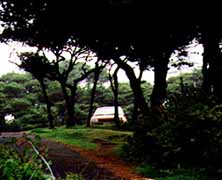
Picnic in Rain
|

and Spume
|
These Pacific beaches are comparatively barren of seawrack, by
east coast standards. Few shells, less seaweed, scant signs of
abyssal life. But the driftwood is immense, and the sands go on
forever. With the low landward-running clouds and the surf-mist,
the distant headlands fade into illusion. You feel you could walk
to Baja. |
We chose to drive, and do the ultimate tourist thing: stop at
a roadside attraction. The Sea Lion Caves. Not without trepidation
we plunked down $6 apiece alongside the stuffed sea-lions, and
stepped through the gate to the brink of the cliffs.. here 335
feet high. Way down there the rollers were tumbling white and
spuming against the vertical walls. You get into an elevator in
the rock wall, and descend 280 feet to come out in a dimlit tunnel
blasted through the solid rock.. filled with the guttural barking
of sea lions. Going down the tunnel, it opens into a 60-foot diameter
cave, one end of which is closed off with a chest-high cement
barrier topped with cyclone fencing. Through the fence you look
down into a huge sea-cavern, with massive rockpiles rising out
of the breaking waves.. covered with sea lions. The whole otherworldly
scene is lit by reflected sunlight shining in the western entrance.
Opposite us a shimmer of light leads down a long tunnel to the
southern entrance, a bright doorway in the distance. The top of
the cavern is a weird landscape painted in green and red algae.
And the sea lions! I’ll let Peggy tell you about the animal magic
of this place. But I can’t take the elevator back to the surface
without reporting on another animal encounter which tells a volume
about our level of absurdity. While we were entranced by the antics
of the seabeasts in their realm, peering out of the shimmering
gloom into the movie set, a young woman carrying a camera and
what looked like a camera bag came up to the barrier, set down
the bag, and began trying to photograph the sea lions. Flash was
proscribed, and she asked us if her picture would come out. We
demurred, and offered her the use of our binoculars. After we’d
all filled our eyes, and recorded the magic cave in our heads,
we went back to the elevator together. In the hallway, echoed
with sea lion barking, the bag started yowling. It was a cat-bag.
She’d brought her pet puss to see the lions. She let him out,
on his leash, and addressed him in reassuring terms, as Jupiter.
He mewed in tune with the wild chorus. O to howl in the deeps..
and not laugh out loud.
(Memo #34)
Oct. 22 - SEA LION CAVE, Oregon Coast
Who? private entrepreneurs
What? cave used by sea lions
Where? on and in a cliff on Oregon coast near Florence
When? since 1932
How? found good roadside cliff, cut 200 ft. elevator shaft down
to sealion cave
Topics: marine mammals, sea caves, tourists & animals
Questions: What is the best way for tourists to view wildlife?
Can animals be viewed in their natural setting without affecting
the animal’s behavior? |
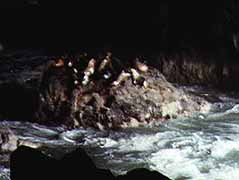
In the Cave
|
The northwest coach of Oregon and Washington states is spectacular.
We have walked on long low sandy dunes at Long Beach and narrow
pebble beaches on the Olympic Peninsula with the great trees coming
down to water’s edge. We have driven along shelves high on mountains
and through groves of giant trees. Except for gulls, our contacts
with animals have been with land animals; we’ve seen eagles and
blacktailed deer and squirrels galore. Today we saw sea lions
in an incredible setting, a huge sea cave deep within a cliff.
We drove around a sharp corner on the high narrow coastal road
just north of Florence, Oregon. The ocean was several hundred
feet below with great rollers coming in from Asia. The information
building advertising SEA LIONS was at the cliff”s edge with a
narrow parking lot between it and the road and more parking carved
out of the mountain across the road. Inside there were souvenirs
and snacks. We were told the entrance fee was $6. We almost didn’t
pay. It’s hard to judge price and value when you travel. The fabulous
Cleveland Art Museum was free, the Cody museums were $8 (but that
gave you access to four museums for two days). I did not expect
$12 to give us magic. It did.
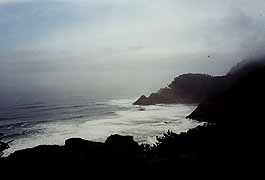
View from above
|
We went down a flight of stairs inside, then outside and down
a walk along the cliff with a wooden railing and gorgeous views
of the coast north and the ocean far below. The walk ended abruptly
under a small wooden canopy. There was an elevator door in the
cliff.
|
The elevator came and we got in. The buttons were a simple arrow
up or down. The indicators over the door told us feet descended.
Over 200 feet in all. The elevator stopped and we were in another
dimension. A corridor with rough stone walls angled gently downward.
The low lighting and railings and displays were those of a hightech
museum. We began to hear bellows. The corridor widened, we passed
a case displaying a full sea lion skeleton, and we were in a subterranean
room overlooking a huge sea cave. We looked through iron mesh
from a sort of balcony shelf high in the cave. The cave floor
was half water with waves rushing in. A jumble of rocks were on
the land side and a huge separate boulder was in the middle with
a jumble of sea lions on it perhaps fifty yards away from us.
Two other sea lions were on the rocks nearer us. There was dim
light from three sea entrances.
We watched entranced. The two near sea lions roared and approached
each other warily and feinted in what seemed like a test of dominance
(between males?). One backed off and finally slid into the water
and swam off. On the separate rock, sea lions slept. I began to
see that there were pairs, mothers and much smaller pups. As we
watched, we saw heads in the water as sea lions swam in from the
ocean. Waves rolled in and lifted them up to where they could
scramble onto the main rock. It took several tries and considerable
skill. Mama got on on the second or third try, pulled herself
laboriously up and them turned and gave what assistance she could
with her flippers to her pup. It took him several more tries but
finally they were both up. They approached the group, but the
nearest mother was wary and aggressive. Her pup obviously wanted
to play with new little one and there was a hilarious bit of bobbing
and ducking as the two pups tried to get around their sparring
mothers to play. The mothers, having done their ritual don’t-mess-with-me
bit, cooled down and the pups played together. Most of the sea
lions seemed asleep.
Sea lions live 20 to 24 years. The adults average 1500 lbs., pups
are 40-50 lbs at birth. The bulls swim as much as 4000 miles a
year. The stellar (northern) sea lion which we saw is “Eumetopias
jubata”, a pinniped, the largest of the otariida (eared seals).
| The sea lion cave is 125 feet high (about 12 stories) and is 2
acres in size. It was formed about 25 million years ago. The viewing
area where we stood is 35 feet above sea level and 300 feet below
the highway level. The cave has three outlets to the south, west,
and north. The western one faces the open sea and it’s the sea
lions’ gate. The northern entrance is entirely above water and
now has a stairway and viewing platform to the sea. Our viewing
balcony was actually part of the northern passage. The southern
opening is a long tunnel from the sea into the cave. Through this
channel in 1880 Captain William Cox brought a small boat and first
saw the cave. |
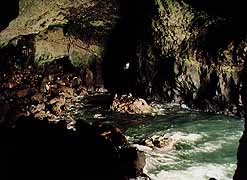
Sea Lion Heaven
|
What is the best situation in which to see wild animals? At the
sea lion cave, the animals seemed unaware of the human spectators
- we were told not to use flashes or talk. The crashing of waves
and bellowing of sea lions was the dominant noise. The lights
in the viewing area were low and there was natural light coming
in from the three natural entrances. We were above the animals
and could not approach them. I didn’t see any of the sea lions
look our way or startle or freeze.
This was very different from the viewing situations in other places
we’ve seen where animals act in a way that seemed unnatural and
certainly not “wild”. At Yellowstone, the elk and buffalo were
everywhere with cars and campers and flashing cameras galore.
People would approach animals closely as singles or in groups,
even with dogs! (We did find out that one of the people watching
the sea lions with us had her cat in her tote bag!) Many of the
violent encounters between tourists and animals occur when the
people violate the animals’ space. In the sea lion cave the spectators
were - wisely, I think - confined to a small area.
The sea lions’ cave is privately owned by several families who
have managed the attraction since 1932. They obviously have thought
the viewing situation through thoroughly. They want the sea lions
to stay - obviously - and have provided the least intrusive viewing
situation they can . The elevator was constructed in stages during
the seasons when the sea lions are not in residence.
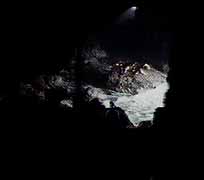
In the Dark
|
10/22.. continued.
The T-magic had worked. And when we stepped out of the elevator at the clifftop we were
blinded by sunlight. Was this recapitulation of myth?
Once upon a time... |
The heavens had been weeping for an age, and the great trees were
throwing their limbs to the ground as they streamed with tears.
The world was gray with sadness. Deep waters surged up the river
valleys trying to hide from the howling winds offshore. The Great
Cloud Being, Cumula, had lost her shining joy in the swallowing
sea, and had come down to churn the waters in search of it.
But only the two-legged clown, who laughed at the drenching sorrow
and thumbed his nose at the winds, could help find her silver
treasure. For only he understood the language of the wild things
who go beneath the waves and come cavorting up to the cliffs,
the barking ones who might know what became of the lost brightness.
And only he knew their secret place within the rock where they
gather to tell lies, and choose their king.
So the two-legged fool made a bargain with the Great Cloud Being.
He would go and ask the wild things of the deep if they knew of
the shining joy, and bring news to Cumula, in exchange for one
gift. The gift of cloudcalling. That he might wrap himself in
mist and shadow at call, or dissolve a fog around him at will.
The bargain was struck, and the two-legged clown entered into
the secret ways, and descended into the seabeasts’ cavern.
“What do you want here with us?” the deep things barked. “Have
you come to tell us the riverfish are running to sea? Have you
come with your clever fingers to heal our wounds? What do you
want with us?”
“No, it is too early for the riverfish to seek the deep waters,”
the two-legged fool replied. “And, yes, I can lay hands on your
wounds, if you wish. But I have come in search of your deepsea
knowledge, for the whole world knows of your wisdom.”
Now the wild seabeasts are not wise at all, except in the breaking
ways of waves, and the dodgings of fish. Their barkings and bellowings
are mostly about who has the softest bit of sealedge, and who
should be king, and "Junior get over here." But they are easily
flattered. As soon as the two-legged clown had sung their praises,
they began stretching out their long necks and looking down on
each other, and started yapping and barking in an ecstasy of self-importance.
“Which of you noble creatures is now king?” asked the fool? And
one huge scarred old warrior bellowed, “It is I, you landthing,
what wisdom do you wish to hear?”
“Only a trifling thing, your highness. Merely a word about something
a friend of mine lost in this great sea of yours.”
“Is it good to eat?” the king bellowed.
“Oh, no,” the clown replied. “It cannot be eaten at all. It is
a shining brightness that used to play in the sky, but is now
lost in the deep waters. Have you heard tell of such a thing?”
“And if I have,” barked the seabeast king, “what will you give
me for such knowledge?” For all the wild things know only the
law of tit for tat.
“I can give you word of Orca,” replied the two-legged one in a
soft voice, and at once the cavern was filled with bellows of
outrage and fear and argument. Above it the tremendous roar of
the seabeast king cowed them into silence.
“We do not speak that name here,” he warned. “What have you to
say about the evil blackfish?”
“Only that he can be seen afar from the headlands above. Perhaps
someone such as I could sit upon those heights in the days when
your children are learning to swim and blow into a great shell
horn to warn you of his coming.”
At this the hubbub broke out anew among the barking beasts, and
again the king had to roar them down.
“This would be a great return for such a little knowledge. It
is no great secret of the deep where the brightness is hid. Why
should you offer to save the lives of our children for such a
trifling?”
“Because the one who searches for the brightness loves it like
a child, as well, and will reward me in turn for the telling.”
“Tell him. Tell him.” The barking chorus cried. And the king bellowed,
“I will.”
“The shining which fell from the sky,” he told the fool, “has
been scattered on the floor of the great deep, and swallowed up
by the hardbacked things which live there. You may find pieces
of it inside the shells of those creatures.”
“Do you have any such creatures I could see?” asked the fool.
And the seabeasts brought him a gigantic shell, whose brightness
filled the whole cavern with a shining light.
“I will take this to the one who seeks,” he said, “and I won’t
forget our bargain.”
And when the two-legged fool came out of the rent seacliff carrying
the shining shell, its brightness shone into the sky, and the
Great Cloud Being put away her sadness, and the whole world sighed
for joy. |
Or so I was told. Actually we have been surprised that the NWCoast
mythos doesn’t seem to deify the great cloud passages, or the
wondrous vegetation. Where are the cloud goddesses or the treebeings?
The natives were fishermen and hunters, to be sure, so the animal
spirits abound in their panoply. But how could they ignore the
forces of nature or the astonishing verdant abundance? Maybe this
thing about ignoring the rain is endemic to the turf.
| Terry told us that the Indians called the Willamette “The Valley
of Destruction.” Was this prophetic of the white invasion, or
an aversion to the rampant fertility of the place? Maybe the luxuriant
vegetation, as viewed by a hunting-fishing culture, was a kind
of green evil. Isn’t it ironic that an agricultural people who
came to such vegetable exuberance as a promised land were too
advanced to worship the Greenmen and the Great Cloud Being? |
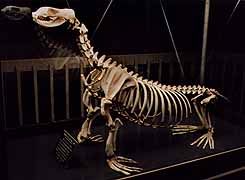
Bare Bones
|
The T-magic only worked for a short spell. Before we were out
of the high twisting vistas of the mountainous coast, and down
into the valley of the Siuslaw, the clouds had returned, if not
the rain. The mountainous shore is succeeded by 30 miles of dunes
which protect a chain of lakes, and a parade of RV-parks and cheap
motels. We swung out onto an overlook to admire the sequence of
dunes and the increasing nastiness of the weather, and swung back
onto the hot-top.

At Coos Bay
|
The Umpqua estuary cuts through the middle of the dunes at Reedsport,
where International Paper fragrances the atmosphere, and dominates
the town, and the Coos River dumps into the pacific at the south
end of the dunes. Coos Bay is the only serious harbor south of
the Columbia on the Oregon coast, and it disgorges timber products
to the world. Container ships, bulk carriers, tugs with rafts
of logs, mountains of chips and sawdust, mega-piles of hardwoods
and softwoods, the sweet smell of sawn timber, and the blowing
of ship’s horns met our passing. The Coos river is full of bungalows
on barges, and rafts of timber, sorted and boomed together behind
rows of pilings running into the stream. |
We’d done enough running with the stream for another day, and
we limped on to the less industrial harbor of Bandon, which is
our present port in the storm.
|
Two strikes for GTE and the motels of Oregon. This is the second
night in a row that we can’t make an e-mail connection thanks
to junk hardware. Somebody must have gone around selling surplus
GTE products to motels about 10 years ago..at least that’s when
these motels rephoned, jack. What surprises us is the total lack
of apology from motel owners. O, the hot water is only lukewarm,
shrug. You want to use a phone? The concept of service is fading
fast as we approach California. Of course the Oregonians blame
everything on the Californians. Too many of them coming in, driving
up prices. Sounds like Mainers talking about Massholes. If Californication
is badacting, seems like it’s catching. Bryce’s road-rules of
thumb: (1) If they’re laughing in the kitchen, the food will be
good. (2) If the price seems high, the service will be bad. (3)If
the phone says GTE, it won’t talk to your computer. |
|







